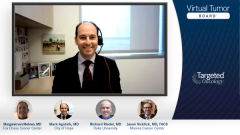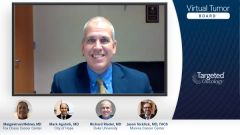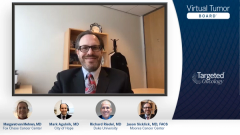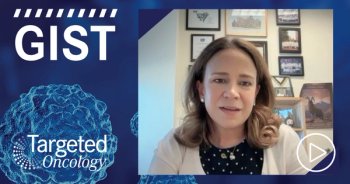
Case 3: Take Home Messages in Treating GIST
The experts comment on take-home messages, and what they hope to see in the future in treating GIST.
Episodes in this series

Margaret von Mehren, MD: Just to finish up, I’m going to ask each of you to give your key take-home message about how you optimize therapy for these GIST patients. What are the things that you think about and do daily? Mark, why don’t you start first?
Mark Agulnik, MD: The take-home for me from this would be that you need to understand the mutation status of your patient. That really gets you the full picture. We treat other diseases. You’d never walk into a patient with breast cancer and not know their ER/PR [estrogen receptor/progesterone receptor] status, their HER2 [human epidermal growth factor receptor 2] status. We have paradigms in other diseases, and we need to do that for this as well. We must understand what the true diagnosis is here rather than just saying GIST [gastrointestinal stromal tumor] isn’t adequate.
We’ve had a lot of therapies. We’ve had two new ones come to market in the last year. We’ll have others in the future. It’s important to maintain dose intensity for our patients, we really have to look at being able to manage the adverse effects of the drugs and use a team approach to be able to get this done effectively for our patients.
Richard Riedel, MD: First and foremost, for a rare disease, patients are best served by being seen and managed in centers with expertise, whether it’s medical oncology expertise, pathologic expertise, or surgical expertise. Molecular testing is required for these patients, particularly if they’re considering any form of systemic therapy. As Mark alluded to, we have 5 FDA-approved agents, and 1 of them is for a specific, albeit rare subtype that otherwise would be resistant to other therapies. Knowing that up front is going to be important if we would expect to impact outcomes for patients in a favorable way.
Jason Sicklick, MD, FACS: I would agree with everything said. Obviously, molecular testing is an important part of the decision-making early on and potentially with later lines of therapy.
Rich, you just alluded to the role of a multidisciplinary approach to caring for these patients is critical. It’s not just continuing therapy when there’s potentially a surgical option available or, as we discussed earlier, liver-directed therapies. It’s trying to bring all the different parts of the team together to identify the optimal timing and treatment options for these patients to potentially resect disease before resistance occurs or treat it later on when it has already occurred but in limited amounts.
Margaret von Mehren, MD: That was great. One of the things when we started getting all these tyrosine kinase inhibitors and it was so exciting to see all these responses, we forgot about the role of surgery. We’ve swung back, and we’re recognizing that it’s not just the medical oncologist. It’s not just the surgeon. It’s really a combination.
Then there are all the other specialties we bring in, including—and we didn’t talk about this—rare occasions where we do bring in our radiation oncologists for painful bone metastases. Occasionally patients have issues with bleeding. It’s very rare these days. Just to reinforce the team approach.
As was said earlier, GIST is not 1 disease. It’s multiple subsets of disease that are characterized by their molecular drivers. Understanding those is really the way to optimize therapy for these patients.
Thank you very much for your thoughtful conversation and presentations and informative discussion. To our viewing audience, thank you for joining us for this Targeted Oncology™ Virtual Tumor Board® presentation. We hope today’s discussion was a valuable use of your time and that you acquired some practical knowledge that you can take back to your clinic. Thank you.
Transcript edited for clarity.













































